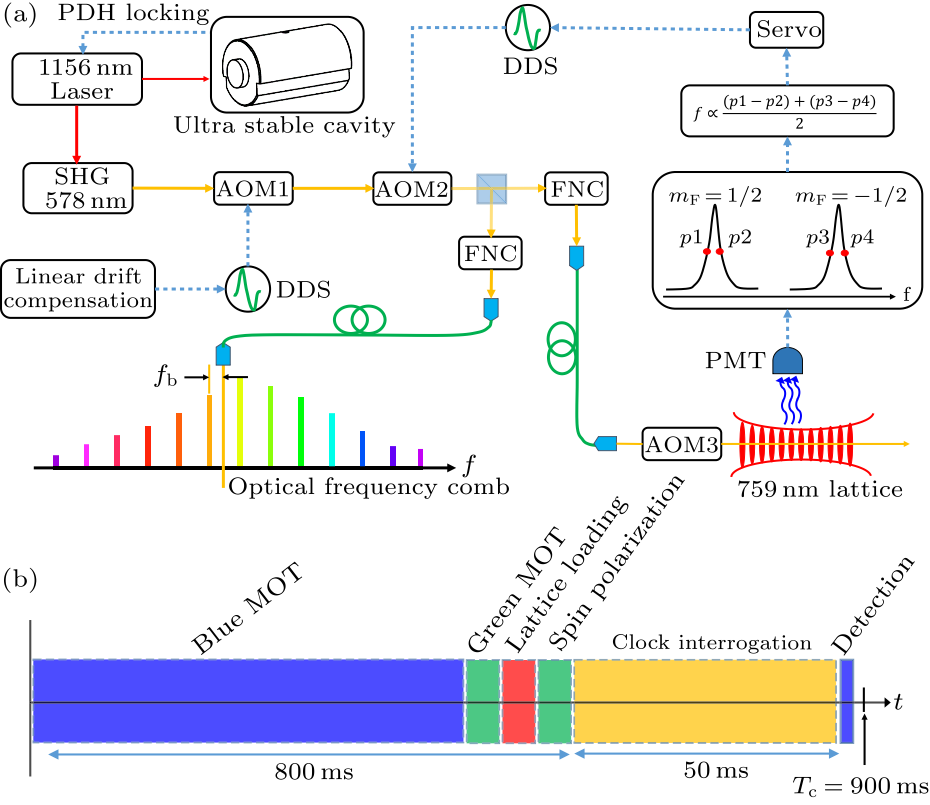
Fig. 1. (Color online) (a) Schematic diagram for the $^{171}$Yb lattice clock. Clock laser at 578 nm is generated by frequency doubling of a 1156 nm semiconductor laser locked to an ultra-stable optical cavity, and then sent to the lattice system and an optical frequency comb for clock interrogation and frequency measurement. Fiber noise cancellation (FNC) systems are used to eliminate the phase noise introduced by fibers. The linear frequency drift of the clock laser is compensated through an acousto-optic modulator (AOM1). Experimental clock cycles alternately interrogate both $m_{F}$ spin states to cancel first-order Zeeman and vector Stark shifts. The frequency correction signal is obtained from the measured excitation ratios near the half maximum, and then used to steer the clock laser frequency through AOM2. AOM3 is used to modulate the clock laser to reach the spin states. (b) Timing sequence for a typical clock cycle of 0.9 s. The servo-loop generates a frequency correction signal every four clock cycles.
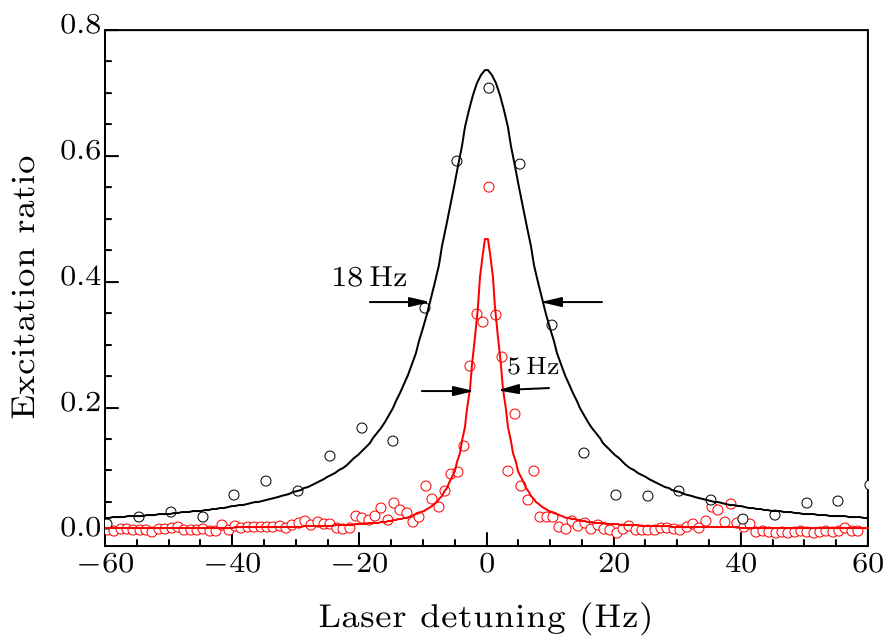
Fig. 2. (Color online) Single-scan normalized excitation spectra of the $^{1}\!S_{0}\rightarrow^{3}\!\!P_{0}$ clock transition of $^{171}$Yb for Rabi interrogation. Black and red circles are the data for interrogation times of 50 ms and 200 ms, respectively. Solid curves are the Lorentzian fits to these data, giving nearly Fourier-limited linewidths of 18 Hz and 5 Hz, respectively.
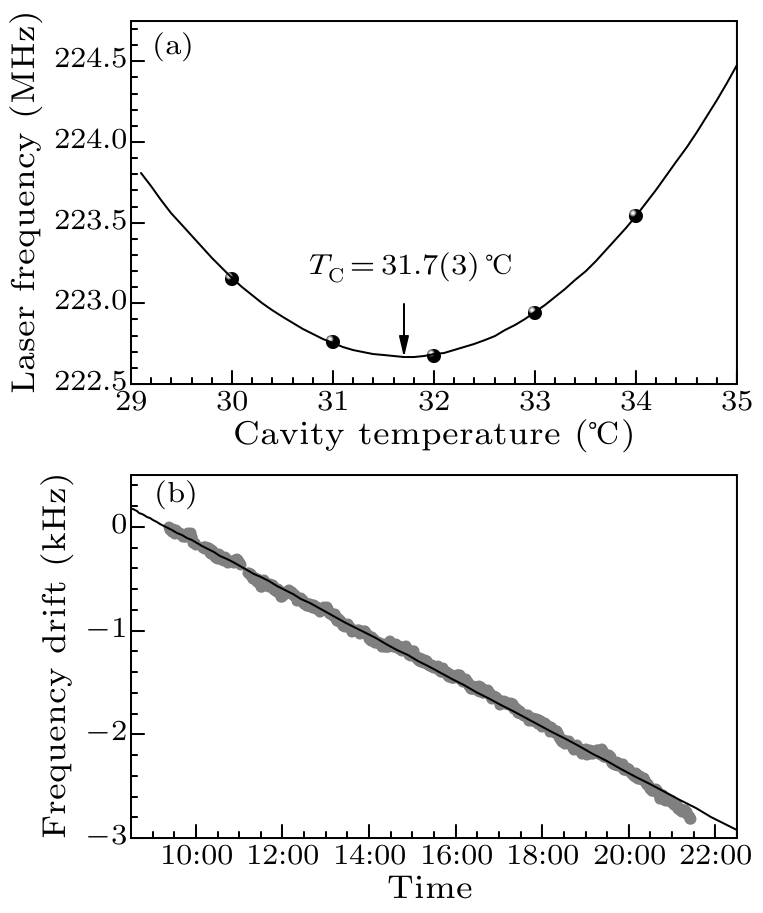
Fig. 3. (a) The frequency of the 578 nm clock laser changes with the temperature of the ULE cavity. The solid line is a 2nd-order polynomial fit to the measured frequency values (solid circles), yielding a zero-expansion temperature of 31.7(3)$^{\circ\!}$C. (b) The measured frequency drift of the clock laser due to the cavity aging. A linear fit (black solid line) gives a drift rate of 60 mHz/s.
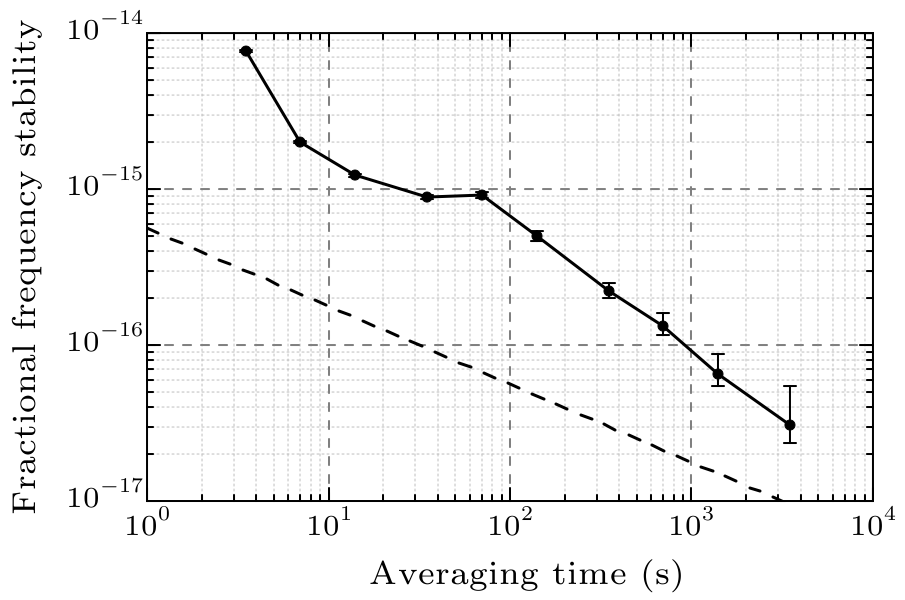
Fig. 4. Instability evaluation of the $^{171}$Yb clock using atomic transition. Solid circles give the in-loop stability (from frequency correction signals) when the clock laser is locked to the atomic transition. The dashed line represents the calculated Dick-effect-limited instability of $5.6\times10^{-16}/\sqrt{\tau}$.
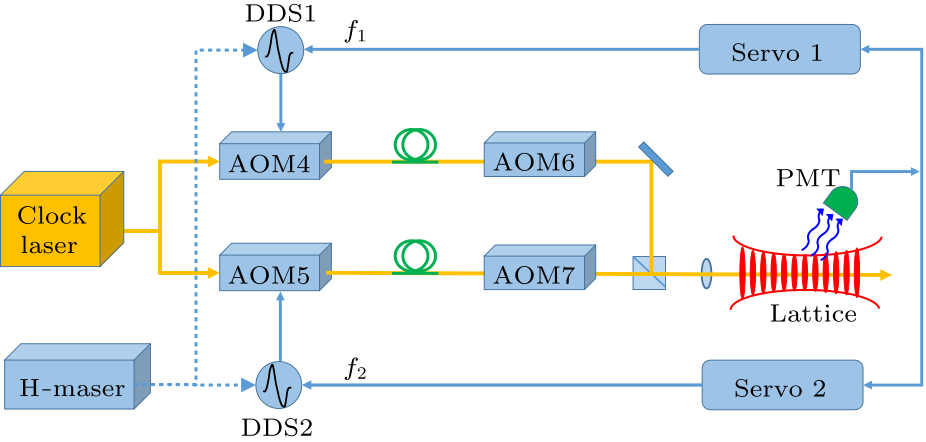
Fig. 5. (Color online) The diagram for interleaved operation of the $^{171}$Yb lattice clock between two independent servo-loops which share the same clock laser. AOM4 and AOM5 are used for fiber noise cancelation and frequency servo control. The other two AOMs (AOM6 and AOM7) are used for frequency modulations of the interrogation beams, and also for the generation of interrogation pulses.
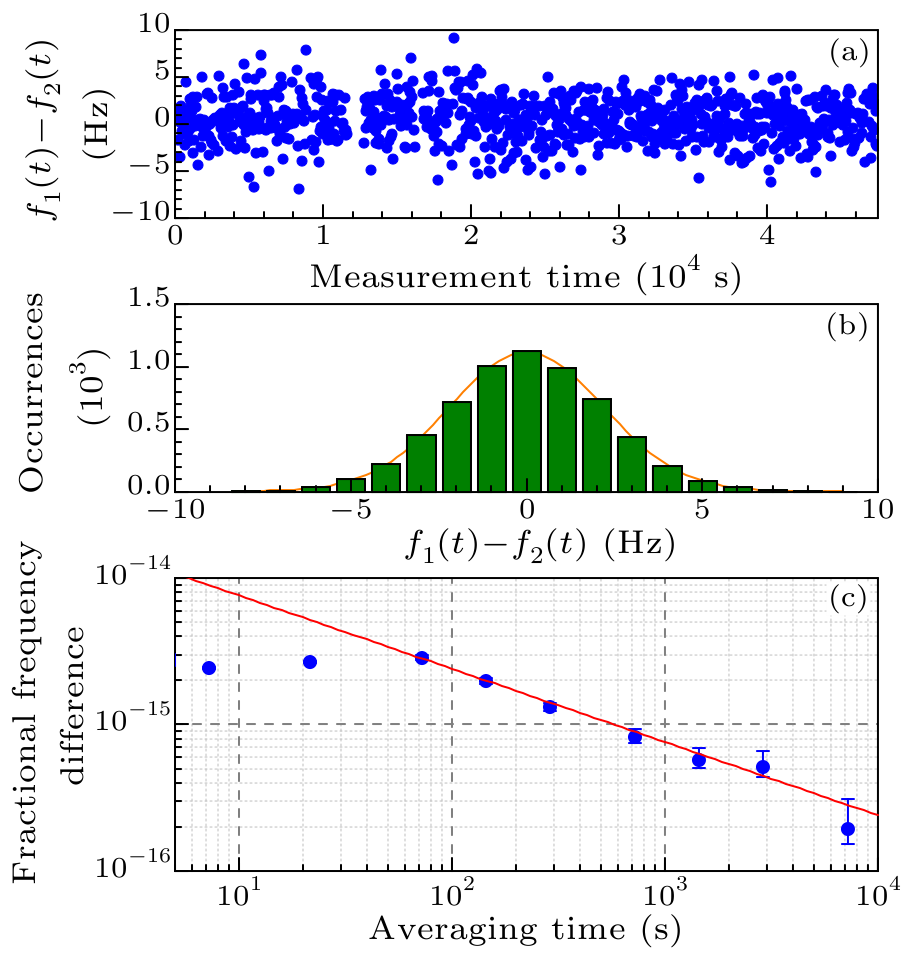
Fig. 6. (Color online) The stability evaluation using the interleaved measurement method as illustrated in Fig. 5. The operation parameters of the clock are the same for the two interleaved servo-loops. (a) Frequency difference of the two correction frequencies, $f_{1}-f_{2}$, for a 48000 s time interval. (b) Histogram of all data and a Gaussian fit ($\chi^{2}_{r}=0.9994$). (c) Fractional frequency difference $f_{1}-f_{2}$. Red solid line represents a white-frequency-noise asymptote of $2.4\times10^{-14}/\sqrt{\tau}$.
| [1] | Nicholson T L et al 2015 Nat. Commun. 6 6896 | Systematic evaluation of an atomic clock at 2 × 10−18 total uncertainty
| [2] | Ludlow A D et al 2015 Rev. Mod. Phys. 87 637 | Optical atomic clocks
| [3] | Huntemann N et al 2016 Phys. Rev. Lett. 116 063001 | Single-Ion Atomic Clock with Systematic Uncertainty
| [4] | Bloom B J et al 2014 Nature 506 71 | An optical lattice clock with accuracy and stability at the 10−18 level
| [5] | Hinkley N et al 2013 Science 341 1215 | An Atomic Clock with 10-18 Instability
| [6] | Chou C W et al 2010 Phys. Rev. Lett. 104 070802 | Frequency Comparison of Two High-Accuracy Optical Clocks
| [7] | Godun R M et al 2014 Phys. Rev. Lett. 113 210801 | Frequency Ratio of Two Optical Clock Transitions in and Constraints on the Time Variation of Fundamental Constants
| [8] | Huang Y et al 2016 Phys. Rev. Lett. 116 013001 | Frequency Comparison of Two Optical Clocks with an Uncertainty at the Level
| [9] | Blatt S et al 2008 Phys. Rev. Lett. 100 140801 | New Limits on Coupling of Fundamental Constants to Gravity Using Optical Lattice Clocks
| [10] | Huntemann N et al 2014 Phys. Rev. Lett. 113 210802 | Improved Limit on a Temporal Variation of from Comparisons of and Cs Atomic Clocks
| [11] | Derevianko A and Pospelov M 2014 Nat. Phys. 10 933 | Hunting for topological dark matter with atomic clocks
| [12] | Chou C W et al 2010 Science 329 1630 | Optical Clocks and Relativity
| [13] | Lin Y G et al 2015 Chin. Phys. Lett. 32 090601 | First Evaluation and Frequency Measurement of the Strontium Optical Lattice Clock at NIM
| [14] | Zhou M et al 2013 Asia-Pacific Radio Science Conference (Taipei 3–7 September 2013) |
| [15] | Lemke N D et al 2009 Phys. Rev. Lett. 103 063001 | Spin- Optical Lattice Clock
| [16] | K Beloy et al 2014 Phys. Rev. Lett. 113 260801 | Atomic Clock with Room-Temperature Blackbody Stark Uncertainty
| [17] | Katori H et al 2015 Phys. Rev. A 91 052503 | Strategies for reducing the light shift in atomic clocks
| [18] | Zhang M J et al 2016 Chin. Phys. Lett. 33 070601 | Hertz-Level Clock Spectroscopy of 171 Yb Atoms in a One-Dimensional Optical Lattice
| [19] | Zhang M J et al 2014 Chin. Phys. Lett. 31 086701 | Creation of 174 Yb Bose—Einstein Condensates in a Crossed FORT
| [20] | Long Y et al 2013 Chin. Phys. Lett. 30 073402 | Observation of Photoassociation Spectra of Ultracold 174 Yb Atoms at 1 S 0 — 3 P 1 Inter-Combination Line
| [21] | Blatt S et al 2009 Phys. Rev. A 80 052703 | Rabi spectroscopy and excitation inhomogeneity in a one-dimensional optical lattice clock
| [22] | Jiang Y Y et al 2011 Nat. Photon. 5 158 | Making optical atomic clocks more stable with 10−16-level laser stabilization
| [23] | Notcutt M et al 2006 Phys. Rev. A 73 031804 | Contribution of thermal noise to frequency stability of rigid optical cavity via Hertz-linewidth lasers
| [24] | Alnis J et al 2008 Phys. Rev. A 77 053809 | Subhertz linewidth diode lasers by stabilization to vibrationally and thermally compensated ultralow-expansion glass Fabry-Pérot cavities